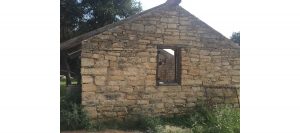By Nicole Barrios
The Kyle Auction Oak, a historical tree and point of pride for community members, is undergoing restoration to keep this Texas historic tree alive for generations to come.
The Auction Oak was the site of the famous 1880 auction in which plots of land were sold when Kyle was founded along the international and great Northern Railroad. Under the shade of the large live oak, the public auction was held and all business as well as most residential lots were sold, according to the Texas Historical Commission.
Located at 204 Sledge Street in downtown Kyle, the large Auction Oak recently began to split in two, causing the Hays County Historical Commission to repair the fracture to ensure the future of the historic tree.
Delbert Bassett, ecology chairman of the Hays County Historical Commission, said they first spotted the crack more than a month ago when it was about one-fourth of an inch wide. By Monday the crack had widened to 1 1/4 inches, causing the commission to contact its arborist to install a cross-bracing strap system in the canopy of the tree, according to Bassett.
The support straps stopped the tree from splitting further, but part of the problem causing the crack was large overhanging branches, Bassett said. The large branches were about one foot thick in diameter and needed to be removed to stop the tree from separating.
“So we removed about 7,000 to 8,000 pounds of wood out of the canopy of the tree,” Bassett said. “And that relieved a lot of the pressure and the tree started coming back together.”
They then replaced the temporary straps in the tree with cables for support, Bassett said. The crack is now about three-fourths of an inch wide, he said.
Vincent Debrock, arborist and co-owner of Heritage Tree Care, has been caring for the Auction Oak for about three years. Improper trimming of the tree was the other reason it split.
“The big problem with the tree is that over many decades it was trimmed improperly, and the bad cuts resulted in massive decay inside the tree,” Debrock said.
The heartwood, or the solid old wood in the tree’s core, that was holding the tree together previously rotted due to the incorrect trimming, Debrock said. The healthy heartwood was supplemented with the cable system, he said.
Safety was also a concern for the oak’s caretakers. Debrock said they had to consider the public’s safety since the tree’s branches were extending over the sidewalk and roadway.
They are discussing the installation of a support system that will include steel beams to brace the heavy branches and prevent them from falling completely, Debrock said.
Debrock said he believes the historical oak is around 300 years old. With the support cables and beams to be installed in the future, the Auction Oak will be able to last for years to come, he said.
To maintain and care for the oak, it costs the commission about $1,000 a year, Kate Johnson, chair of the Hays County Historical Commission, said.
The commission is responsible for the tree’s repairs and maintenance, she said, not the owners of the home and yard in which the tree sits.
Although it costs $1,000 a year to maintain the tree, the recently installed support cable project was an additional cost, Johnson said. An anonymous donor provided the funding for the support cables to fix the splitting tree, she said.
It usually costs around $1,000 to install a cable system like the one in the Auction Oak, Debrock said. Each pier or steel beam they are hoping to later install could each cost an additional $1,000, he said.
The commission is trying to raise funds for the custom support beams that will help the tree, Johnson said.
“It’s a historic tree, it was under it that Kyle got started,” Bassett said. “There was nothing, there was no part of a town whatsoever until they held the auction. It was the shade of that tree people got under for the auction.”
The tree sits on a property that is currently for sale, Johnson said. See the story in the business section of this edition of the Hays Free Press for more information about buying a home with a historic marker on it.
Because the Auction Oak is a historical site and the tree is registered by the Texas A&M Forest Service, Johnson said she would ask future homeowners to be respectful of the tree by not climbing on it and striving to protect it.
“It’s a part of our history of Kyle and also of Hays County, knowing that there’s something tangible that you can go and see that’s a part of our history,” Johnson said. “And it’s a living growing thing, so it’s just something really nice.”










